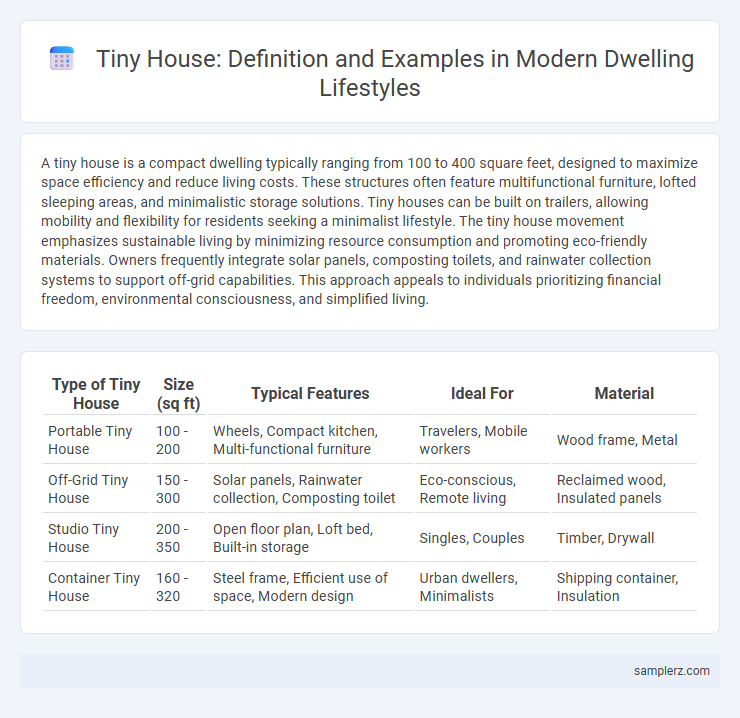A tiny house is a compact dwelling typically ranging from 100 to 400 square feet, designed to maximize space efficiency and reduce living costs. These structures often feature multifunctional furniture, lofted sleeping areas, and minimalistic storage solutions. Tiny houses can be built on trailers, allowing mobility and flexibility for residents seeking a minimalist lifestyle. The tiny house movement emphasizes sustainable living by minimizing resource consumption and promoting eco-friendly materials. Owners frequently integrate solar panels, composting toilets, and rainwater collection systems to support off-grid capabilities. This approach appeals to individuals prioritizing financial freedom, environmental consciousness, and simplified living.
Table of Comparison
| Type of Tiny House | Size (sq ft) | Typical Features | Ideal For | Material |
|---|---|---|---|---|
| Portable Tiny House | 100 - 200 | Wheels, Compact kitchen, Multi-functional furniture | Travelers, Mobile workers | Wood frame, Metal |
| Off-Grid Tiny House | 150 - 300 | Solar panels, Rainwater collection, Composting toilet | Eco-conscious, Remote living | Reclaimed wood, Insulated panels |
| Studio Tiny House | 200 - 350 | Open floor plan, Loft bed, Built-in storage | Singles, Couples | Timber, Drywall |
| Container Tiny House | 160 - 320 | Steel frame, Efficient use of space, Modern design | Urban dwellers, Minimalists | Shipping container, Insulation |
Innovative Tiny House Designs for Modern Living
Innovative tiny house designs integrate multifunctional furniture and sustainable materials to maximize space efficiency and environmental friendliness. These dwellings often feature smart storage solutions, foldable walls, and solar-powered energy systems to support modern living needs. Compact layouts prioritize natural light and open-plan concepts, enhancing comfort without sacrificing style or functionality.
Creative Space-saving Solutions in Tiny Dwellings
Innovative space-saving solutions in tiny dwellings include multifunctional furniture such as fold-out beds, wall-mounted desks, and built-in storage compartments that maximize every inch of available space. Vertical storage systems and modular shelving units allow residents to organize belongings efficiently while maintaining a clutter-free environment. Creative use of convertible spaces, like a dining area that transforms into a workspace, exemplifies the adaptability crucial to tiny house living.
Eco-friendly Features in Tiny House Examples
Tiny houses like the EcoCapsule incorporate solar panels and rainwater harvesting systems to minimize environmental impact while maximizing energy efficiency. These dwellings use sustainable materials such as reclaimed wood and recycled insulation, reducing carbon footprints and promoting green living. Compact designs often include composting toilets and energy-efficient appliances, further supporting eco-friendly lifestyles.
Minimalist Interiors: Tiny House Inspiration
Minimalist interiors in tiny houses emphasize functional design, maximizing space with built-in storage solutions and multipurpose furniture. Natural light and neutral color palettes create an airy, open feel despite limited square footage. These tiny homes prioritize simplicity, comfort, and sustainability, inspiring a lifestyle centered on intentional living and decluttered environments.
Remarkable Tiny House Communities Around the World
Remarkable tiny house communities such as Boneyard Studios in Washington and the Tiny House Village in Minneapolis showcase innovative, sustainable living solutions that maximize limited space without sacrificing comfort. These communities emphasize eco-friendly materials, minimalist design, and shared amenities, fostering a strong sense of community among residents. Their global popularity reflects a growing trend toward affordable, environmentally conscious lifestyles in urban and rural settings alike.
Off-grid Living: Tiny House Success Stories
Off-grid living in tiny houses demonstrates remarkable sustainability and self-sufficiency, exemplified by models like the Tumbleweed Cypress and Escape Traveler. These dwellings utilize solar panels, rainwater harvesting systems, and composting toilets to minimize environmental impact while maximizing comfort and mobility. Success stories highlight how efficient design and renewable energy integration enable homeowners to live independently, reducing reliance on traditional utilities.
Sustainable Materials Used in Tiny House Construction
Tiny houses often incorporate sustainable materials such as reclaimed wood, bamboo, and recycled steel to minimize environmental impact during construction. Insulation made from sheep's wool or recycled denim enhances energy efficiency, reducing heating and cooling needs. Solar panels and green roofing materials further support eco-friendly living by harnessing renewable energy and improving insulation.
Compact Luxury: High-end Tiny House Examples
High-end tiny houses exemplify compact luxury by incorporating premium materials such as Italian marble countertops, custom cabinetry, and smart home technology within a limited footprint. Examples like the New Frontier Nomad and Escape Traveler blend sophisticated design with space-saving solutions like fold-out furniture and multi-functional rooms. These tiny homes demonstrate that luxurious living can thrive in less than 500 square feet without sacrificing comfort or style.
Clever Storage Ideas in Tiny House Living
Maximizing space in a tiny house requires innovative storage solutions such as under-stair drawers, multi-functional furniture like beds with built-in storage, and wall-mounted shelves that utilize vertical space efficiently. Modular units that can be reconfigured according to needs help maintain a clutter-free environment, enhancing both functionality and comfort within limited square footage. Clever storage designs contribute significantly to optimizing every inch of a tiny dwelling, making small living practical and stylish.
Real-life Transformations: From Standard Homes to Tiny Houses
Real-life transformations from standard homes to tiny houses showcase efficient use of space, sustainability, and minimalist living. Families downsize to models like the 200-square-foot Tiny Heirloom or the 250-square-foot Escape Traveler, prioritizing multifunctional furniture and eco-friendly materials. These tiny dwellings reduce utility costs and environmental impact while encouraging a simpler, more intentional lifestyle.

example of tiny house in dwelling Infographic
 samplerz.com
samplerz.com